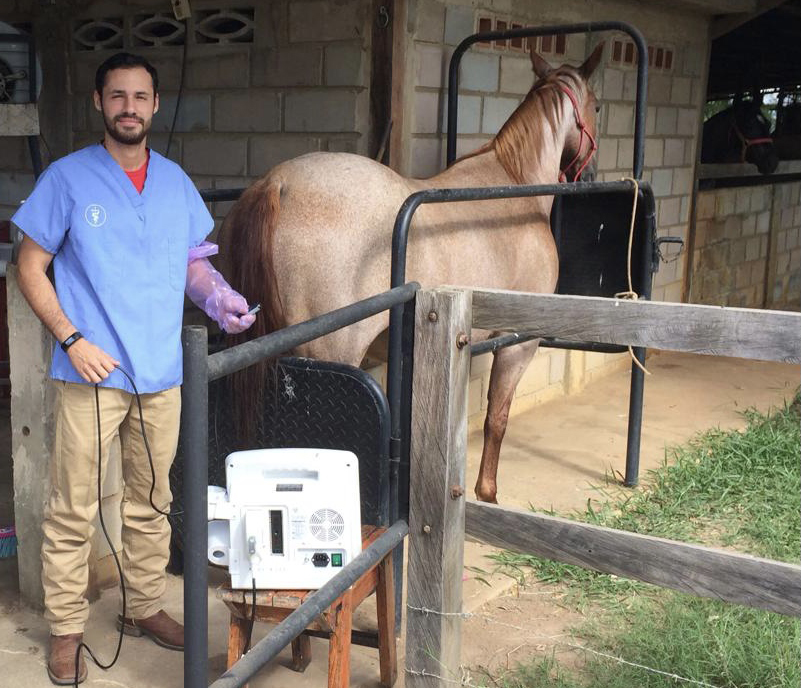In the world of veterinary reproduction in horses, one of the most widely used biotechnologies is Artificial Insemination. This technique is used in any species, and even in human beings, having a very important impact on society.
Over the years the use of this technique has been improved with the aim of making it as successful as possible, to obtain pregnancy in the female as a final result. In other articles published by me I have talked a little more about Artificial Insemination.
Like any other technique, it depends on several factors, both external and internal regarding the mare, or failing that, the male horse, and in turn the professional who practices it.

Artificial insemination, abbreviated as AI, must be carried out in a very careful, detailed and aseptic manner as possible to increase the chances of success. However, at this moment I want to express a very important point when carrying out insemination in a mare, and it is about the moment of insemination, since if we want to cross the male with the female in a natural way or through the mentioned, we must know the optimal moment for said act.
Throughout my studies on the behavior of the reproductive tract of a mare and the comparisons I have made with other studies carried out, we realize that there are several factors that help determine the ideal moment to deposit the horse’s semen in the uterus of the mare. horse.
In this particular article I want to highlight one of the factors that for me is of vital importance – along with other aspects – when detecting the moment of ovulation, which is Uterine Edema. We define it as the accumulation of fluid, in this case physiological, that is found in the body and uterine horns.
In mares when they are in their physiological stage of estrus (heat) – stage where they accept the male -, the predominant hormone in their circulation is estrogen, which generates an increase in irrigation in the reproductive tract and makes the entry of fluid permeable. to the uterus, thus generating the so-called “Uterine Edema”. This entry of fluid into the lumen of the uterus is intended to generate an optimal environment and thus prepare said organ for fertilization.
Brinsko et al., 2010, consider that through ultrasound, many parameters such as follicular development, presence of pathological fluid in the uterus, presence of corpus luteum (CL) and Uterine Edema, can be monitored throughout the estrous cycle, thus helping to identify and be able to determine the moment of ovulation.
In this sense, for Reilas et al., 2015, the characteristic morphological interpretation of the endometrium on ultrasound constitutes an important part of establishing an accurate estimate of the stage of the estrous cycle. The appearance of edema precedes the onset of estrous behavior by 1, 2, or 3 days, although sexual behavior generally persists for 24 to 48 hours after the edema has disappeared.
The Edema scoring system developed by Samper, 2009 has been a very useful tool to determine the appropriate time of ovulation in mares. The parameters are described below:
- Moderately soft uterus, with slight presence of echogenicity, 25-35mm follicles appear.
- First real sign of edema, the mare is going into estrus. Elongated endometrial folds, easy identification. Follicles larger than 35mm.
- Endometrial folds that are easy to see, follicles measuring 38mm or more, a “car wheel” appearance. Indicative of near ovulation.
- Increased endometrial folds, the “car wheel” appearance continues, follicles larger than 40mm. At this stage the edema begins to decrease and ovulation is closer.
- It is considered abnormal. Endometrial folds thickened, car wheel appearance is lost. They persist even after ovulation and may continue to accumulate fluid.
According to Brinsko et al., 2010 in their Manual of Equine Reproduction, the endometrial folds of the mare in estrus become prominent, generating a heterogeneous appearance on ultrasonography. The classification of endometrial edema can also be classified as 0 (no edema), 1 (slightly), 2 (moderate), 3 (severe).
Uterine edema may be indicative of some pathology when we observe one or more of the following aspects: presence of clear endometrial edema and a large dominant follicle 14-15 days after ovulation, failure to reduce edema when the mare reaches ovulation or 24 hours post-ovulation, presence of hyperedema (ED5 or greater) in a normal estrous cycle, significant increase in edema 12-24 hours post-ovulation and absence of uterine edema during estrus (McKinnonet al. 1988, Pelehach et al. 2002, Squires et al.1988).
Miro et, al., 2004 explains that hypoechoic areas in the ultrasonographic image are the result of submucosal fluid (edema). The degree of Uterine Edema increases with follicular growth, the edema generally reduces or stops one day before ovulation.
In a work published in 2012 by the Veterinary Medical Journal of Colombia, 24 Colombian mares, between the ages of 4 and 14 years, were inseminated and subsequently monitored by ultrasound from the day of ovulation until 40 days later. evaluating different parameters; among them the degree of Uterine Edema, resulting in the predominant Uterine Edema in the mares at the time of ovulation being classified as zero grade (0). On the day of ovulation (day 0), 2 mares were found with grade 2 edema and one mare with grades 1 and 3 edema, which disappeared during the following days.
After knowing the study mentioned above, we can compare it with the results obtained by me in 8 quarter horse mares where it was observed that at the time of ovulation 5 of them had grade 1 edema, while the rest had grade 2. Furthermore, one of them had the presence of a 39mm follicle and grade 3 edema, and 24 hours later it had a 44mm follicle and grade 2 edema in the process of regression.
After having observed the constant behavior of Uterine Edema in both works, at the time of ovulation it is vital to know the importance of said Edema to deduce the moment of ovulation, and in this way, specify the ideal moment of service in the horse. On the other hand, it is observed that there is a very close relationship between follicular growth and the behavior of Edema, having an increasing and then decreasing development as the release of the egg approaches.


Recent Comments